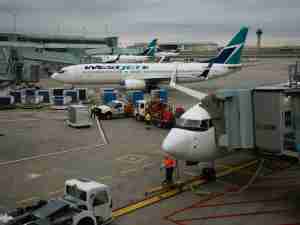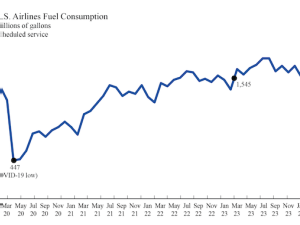Fitch Ratings has affirmed the ratings for San Antonio, TX's (SAT) approximately $185.1 million of outstanding senior general airport revenue bonds (GARBs) at 'A+'. Fitch also affirmed SAT's $125.3 million outstanding subordinate airport passenger facility charge (PFC) revenue bonds at 'A'.
KEY RATING DRIVERS
The ratings reflect San Antonio Airport's (SAT) resilient and largely origin & destination (O&D) traffic and demand that is supported by a moderate carrier diversification. Although SAT faces competition from nearby Austin-Bergstrom International Airport, SAT is served by carriers that continue to expand domestic routes. The airport also utilized a compensatory airline use and lease (AUL) agreement, which has stabilized and improved financial performance. Despite a sizable reduction in cash, leverage at 6x in 2017 remained in line with previous years, and is expected to step down in the coming years despite the expectation of additional debt in the medium term. All-in DSCR remained healthy at 1.5x.
Growing Travel Market, Carrier Diversity (Revenue Risk: Volume - Midrange):
The San Antonio Airport (SAT) serves a strong origination and destination (O&D) passenger base, which represents 98% of its 4.4 million enplanements, though the proximity of Austin-Bergstrom International Airport hampers SAT's ability to grow regional market share. SAT is served by diverse carriers and continues to grow air service, which further stabilizes the overall enplanement base.
Lease Agreement Provides Stability (Revenue Risk Price - Midrange):
The compensatory airline use agreement provides SAT with pricing flexibility and helps maintain a competitive cost profile via revenue sharing mechanisms. However, the agreement could exacerbate revenue and operating margin volatility, as reductions in non-airline revenue would not be covered through additional airline charges. Recently, the airport and airlines agreed to a three-year extension of the Use and Lease Agreement through fiscal 2020.
Limited Capital Program (Infrastructure Development & Renewal - Stronger):
The airport's $277 million five-year CIP is manageable, with borrowing expected to represent less than 50% of anticipated funding requirements. The airport is currently developing a new Master Plan, with defined debt amounts and timing uncertain at this point, yet the city has put in place an interim financing plan to fund immediate needs. Phase 2 Terminal A Renovations as well as a new CONRAC facility are currently in progress.
Conservative Debt Structure (Debt Structure - Stronger (Sr), Midrange (Sub)):
All of SAT's outstanding senior and subordinate debt is fixed-rate obligations with current annual debt service requirements stepping down over time, beginning in 2019. Additional debt issuance is expected in the medium term, and will be layered into the existing amortization schedule. Covenants and reserves for both debt liens are generally standard for airport credits, and the subordinate lien bonds are additionally secured by a first lien pledge of the airport PFC receipts.
Financial Metrics
In Fiscal 2017, leverage was moderate at 6x net debt to cash flow available for debt service (CFADS). Fitch-calculated senior DSCR was 1.8x (1.6x without transfers) in fiscal 2017, and Fitch expects DSCRs to remain around these levels under Fitch's base case conditions. 2017 all-in coverage was 1.5x (1.4x without transfers) and is similarly expected to remain around this level in Fitch's Base case. PFC collections alone have been supporting the subordinate lien debt service by over 1.3x. CPE increased to $7.60, while liquidity increased to 160 days cash on hand (DCOH), which is very low relative to peers.
PEER GROUP
San Antonio's peers include Raleigh-Durham Airport (AA-/Stable) and Albuquerque (senior A+/Stable; sub A/Stable). Compared with SAT, Raleigh-Durham has a slightly larger enplanement base of 5.6 million, more robust coverage of 1.7x, and slightly lower CPE and leverage levels at $7.28 and 3.4x, respectively. Albuquerque has a similar O&D percentage, but has a much lower enplanement base than the others at 2.4 million, low leverage at 1.3x, CPE at around $7.46, and robust all-in coverage at 1.9x.
RATING SENSITIVITIES
Future Developments That May, Individually or Collectively, Lead to Negative Rating Action:
--Material increases in airport capital spending and associated debt requirements, bringing leverage above the current expectations of 5x-6x on a sustained basis;
--Elevated volatility or material decrease in traffic and/or increase in costs leading to an unsustainably higher CPE.
Future Developments That May Lead to Positive Rating Action:
--Given the airport's expected leverage metrics and current revenue risk profile, positive rating action is unlikely at this time.
CREDIT UPDATE
Performance Update
2017 enplanements increased 3% to 4.4 million as economic conditions in the area continue to improve and airport demand increases. Fiscal-year (FY) 2018 enplanements have grown by 9.3% through June. Management is conservatively forecasting annual enplanement growth of 2% for FY2019 through FY2022.
2017 revenues decreased by 2% to $94.7 million mainly due to a 4% decline in non-airline revenues, namely miscellaneous revenues and transfers from other funds. Airline revenues increased by 2%. Estimated 2018 revenues increased by 7%, mainly due to increased airline revenues, driven by the increased traffic. 2017 operating costs grew 3% to $60.7 million. The Airport is in the process of updating its financial forecasts and operating expectations as a part of its Airport Master Plan in FY20. In the near term, the management states that it will manage expenses in a conservative manner, though the FY19 proposed budget anticipates a 4% increase in expenditures.
The airport provided a six-year (FY2018-2023) CIP totalling $277 million (which has not changed since last year's review), which will be funded by a mix of grants, PFCs, Airport bonds, CFC Bonds, and the airport improvement & contingency fund. At this time, SAT is developing a Master Plan that will present all alternatives for Airport development to meet community requirements. Once the Master Plan has been completed, the financing plan for the Airport to include all assumptions will be updated to support this plan. As such, in order to support the current capital program, the city put into place an interim financing note program (up to $100 million) that is secured by property taxes but paid with Airport revenues. This interim financing provides the Airport the flexibility to move forward with the current capital improvement program while the Airport Master Plan is being updated.
Fitch Cases
Fitch's cases, which span from 2018 to 2024, use the issuer's fiscal 2018 traffic and revenue budget assumptions while adding additional assumptions and stresses. Additional debt issuance of $100 million was incorporated into the pro-forma projections to reflect the permanent financing of the interim capital program. Under the base case, enplanements grow at a CAGR of 1.5%. Following estimated assumptions for fiscal 2018 and budgeted assumptions for fiscal 2019, non-airline revenue growth rates follow annual traffic changes, while airline revenues grow at an annual rate of 3%. Fitch-calculated average DSCR on GARB debt is strong at 1.6x (1.5x without prior-year transfers). Average all-in coverage is also healthy, averaging 1.4x, with CPE rising to $8.93. Despite the inclusion of the additional $100 million of debt, leverage falls to an average of 6x as debt is repaid.
Under the rating case, traffic is stressed 5% in 2020, followed by annual recovery thereafter. Revenue changes are the same as under the base case and operating expenses are stressed an additional 0.5%. Fitch-calculated average DSCR on GARB debt stands at 1.5x (1.4x without prior-year transfers). Average all-in coverage is still adequate at 1.3x (1.2x without transfers), while average CPE grows relatively high to $9.49. Despite added debt issuance, average leverage is still manageable at 6.5x.








